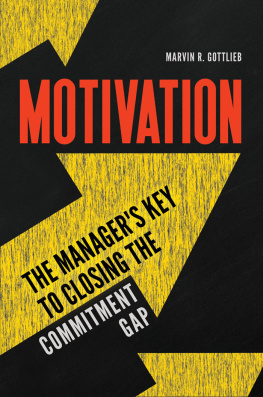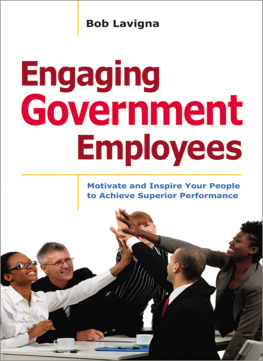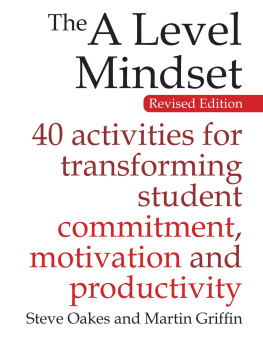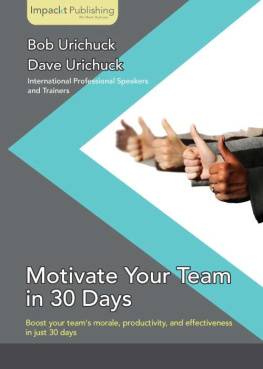Motivation
Motivation
The Managers Key to Closing
the Commitment Gap
Marvin R. Gottlieb

Copyright 2017 by Marvin R. Gottlieb
All rights reserved. No part of this publication may be reproduced, stored in a retrieval system, or transmitted, in any form or by any means, electronic, mechanical, photocopying, recording, or otherwise, except for the inclusion of brief quotations in a review, without prior permission in writing from the publisher.
Library of Congress Cataloging-in-Publication Data
Names: Gottlieb, Marvin R., author.
Title: Motivation : the managers key to closing the commitment gap / Marvin R. Gottlieb.
Description: Santa Barbara : Praeger, [2017] | Includes bibliographical references and index.
Identifiers: LCCN 2017025911 (print) | LCCN 2017028371 (ebook) | ISBN 9781440859342 (ebook) | ISBN 9781440859335 (alk. paper)
Subjects: LCSH: Employee motivation. | Communication in management.
Classification: LCC HF5549.5.M63 (ebook) | LCC HF5549.5.M63 G678 2017 (print) | DDC 658.3/14dc23
LC record available at https://lccn.loc.gov/2017025911
ISBN: 978-1-4408-5933-5 (print)
978-1-4408-5934-2 (ebook)
21 20 19 18 17 1 2 3 4 5
This book is also available as an eBook.
Praeger
An Imprint of ABC-CLIO, LLC
ABC-CLIO, LLC
130 Cremona Drive, P.O. Box 1911
Santa Barbara, California 93116-1911
www.abc-clio.com
This book is printed on acid-free paper 
Manufactured in the United States of America
To my family: Gail, Aaron, Courtney, Payton, and Parker
Contents
Acknowledgments
This book would not have been completed without the encouragement and support of Lori A. Conkling, Continuing Education Director of Labor Market Research & Workforce Development at Queensborough Community College, City University of New York, and Adjunct Assistant Professor at St. Johns University. As a longtime friend and colleague, she provided the impetus and editorial support that moved me along when my own motivation was flagging. I am grateful for her friendship and the significant contribution she made toward completing this project.
Introduction
My grandfather came to the United States with the wave of immigrants in the 1890s. In Eastern Europe he was a cooper. For those of you who dont know what a cooper is, he made barrels. He brought his skill to the new country, and changing along with the times, he evolved his craft from using wood to using metal. Whether using metal or wood, the premise of a barrel remains the same. It is usually used to contain liquids, and there needs to be a way to get the liquid both into and out of the container. To accomplish this, it was necessary to drill holes in each of the newly fabricated barrels. The men who were hired to drill these holes had a very clear motivation. They were paid five cents for each hole that they drilled. So, at the end of the day, my grandfather, or somebody else working in a supervisory capacity, would go to each mans workstation and simply count the number of holes that had been drilled into the barrels on that particular day. The men were then compensated based on their output. Motivation of this type could be characterized as purely economic. The faster a man worked, the more holes he drilled, the more money he earned. Vestiges of this economic model continue to exist in some places today, particularly in developing countries, but they are the exception rather than the rule in the West.
It is not the purpose of this book to retrace the historical changes taking place in the workforce during the last century as well as the beginning of this century. However, as background, we can highlight a few key changes that have brought us to the present day. No one would dispute that there has been a continuing shift from manual labor to what Peter Drucker called the knowledge worker in his 1967 book, The Effective Executive.is responsible for a contribution that materially affects the capacity of the organization to perform and to obtain results.
In 1981 Daniel Yankelovich presented some extraordinary findings and conclusions about changes in the workforce in his book New Rules: Searching for Self-Fulfillment in a World Turned Upside Down. The Yankelovich research pointed to a new social ethic gradually taking shape. He called it an ethic of commitment to distinguish it from the traditional ethic of self-denial that underlies the old giving-getting compact that we lived with for a greater part of the 20th century.
Among other things, the research revealed that one group of working Americans place their personal self-fulfillment high above all other concerns about earning money, having security, performing well, and working in a satisfying job. This group constituted about 17 percent of all working Americans. They were younger than average, and more of them were professionals than among average Americans. They were also the best educated of five groups, with more than half (51 percent) having received at least some college education. Also, their parents had much more college education than the rest of the working population (42 percent compared to 21 percent). For our purposes, the most important phenomenon that emerges from this early research about these dynamic shifts in American values and attitudes is referred to by Yankelovich as the commitment gap.
Subsequent surveys, such as those conducted by the New York Citybased Families and Work Institute, further defined the dynamic landscape of worker perceptions, values, and meanings as they pertain to our complex relationships with our work. One enduring value that emerged from this research, as well as other surveys, shows that people continue to have a strong need for achievement and self-actualization, and they continue to believe in work as a prime self-identifier. At the same time, todays worker feels that he or she has at least some if not a large degree of freedom in deciding how to do their work. This book examines the fine balance of individual autonomy and bottom-line accountability.
With increasing autonomy comes the possibility of the widening of Yankelovichs commitment gap. Knowledge workers have a measure of discretionary effort while performing their jobs. Much of this freedom is a result of the job itself; some may derive from modern management practices that create more individual freedom simply because there are fewer managers, or because the manager-worker relationship is virtual. In any case, there is a surprisingly high percentage of workers who decide when and how their work gets done. While this is what should be expected of most professionals given the current business climate, the commitment gap has the potential to expand. What is the quality and quantity of the work done within those self-imposed time frames? More important, how satisfied are those workers with their produced work? How motivated and committed do they feel toward their organizations?
More than ever, senior frontline managers are faced with the development and maintenance of highly productive teams comprised of people who often have a portion of discretionary effort that they can offer to the task or withhold without detection. When this is added to the growth of virtual teams, the managers ability to motivate becomes a critical part of his or her leadership challenge. Organizational quests for lean, highly responsive, changing, and adaptive workforces have created an environment where every available portion of productivity must be tapped to meet increasingly competitive global goals.
Success for todays manager means building and motivating teams. In order to do so, managers need to understand the raw material they are using. What are some of the key features of this knowledge-worker population? The Families and Work Institutes National Study of the Changing Workforce is designed to reveal new insights about changing generational and gender dynamics in the American workforce, workplaces, and families. It illustrates some striking changes in workers values, attitudes, and beliefs. Because this study provides some relevant insights, it will be referred to periodically throughout this book.
Next page










